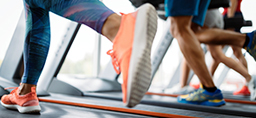
You resolve to exercise, with visions of a leaner, fitter, stronger you in the months ahead.
You will climb that mountain, run that 5K, ski, swim, bike—or maybe just power-shop with ease.
How to make your grand plan stick?
Here are 10 tips from Phillip Adler, ATC, manager of the Spectrum Health Sports Medicine program.
Make a date
If you schedule time to exercise and put it on the calendar, you are more likely to make it happen. An online calendar with pop-up reminders is an added plus. And if other people have access to that calendar, that can only increase accountability.
Use an activity tracker
It can be as simple as a pedometer or the most sophisticated Fitbit—anything that measures how much you do (or don’t do) can remind you to get moving.
Have fun
If you find activities that keep you engaged, you are more likely to come back for more. Try a group activity, like step aerobics or a boot camp class. But be conscious of the level of the class—and whether you are ready for it.
Get SMART
A SMART goal is specific, measurable, attainable, realistic and timely. For example, you might aim to progress from 20 minutes of walking to 20 minutes of running. When you set goals, it helps to begin with the end in mind and figure out the steps needed to get there.
Adopt a habit
How long it takes for a new pattern to become an automatic one varies from person to person. Researchers have floated numbers ranging from 21 to 66 days. The key is to hang in there long enough so exercise becomes the norm. Eventually, you won’t be able to imagine life without it.
Revise goals if necessary
You can make your fitness goals more difficult as you make progress. And you can loosen up a bit if you feel overwhelmed. Instead of giving up, revise and refocus. Failure is not a bad thing if we learn from it.
Don’t let soreness deter you
It’s OK to push yourself a little, and feel achy muscles the next day. Back off if you see serious effects—like persistent swelling, a limp or an inability to reach for an object. But if you haven’t done much exercise in a while, it’s normal to feel some soreness. Keep moving the next day—use those muscles.
Hydrate
It’s important to make sure you have plenty of water, especially in the winter when the air is dry. When you are hydrated, you will have a better workout. If your lips are chapped or you can write your name on the back of your hand, you need water.
Look at the big picture
Make your commitment to exercise part of an overall healthy lifestyle. Aim to sleep better and eat a healthy diet—both will help you get the most from that time you spend at the gym.
Seek help
There are plenty of experts who can help you set up a plan that works. Be sure they have training and credentials, such as certification from the American College of Sports Medicine or the National Strength and Conditioning Association. These folks can get you moving in the right direction.
 /a>
/a>
 /a>
/a>
 /a>
/a>
I have started my healthy lifestyle plan now, I choose not to eat sugar, starch or dairy and
plan on working out every day except on weekends.
That’s awesome, Lisa! You can do it! 🙂